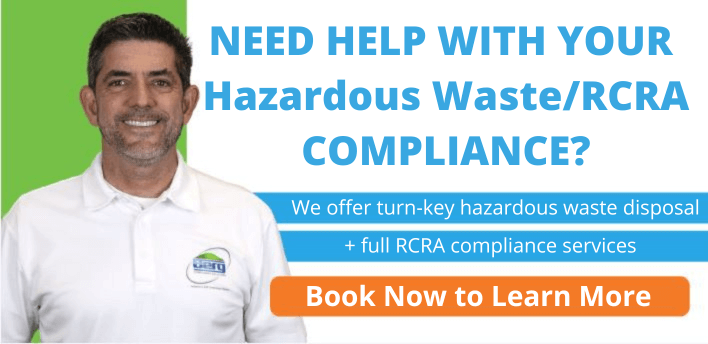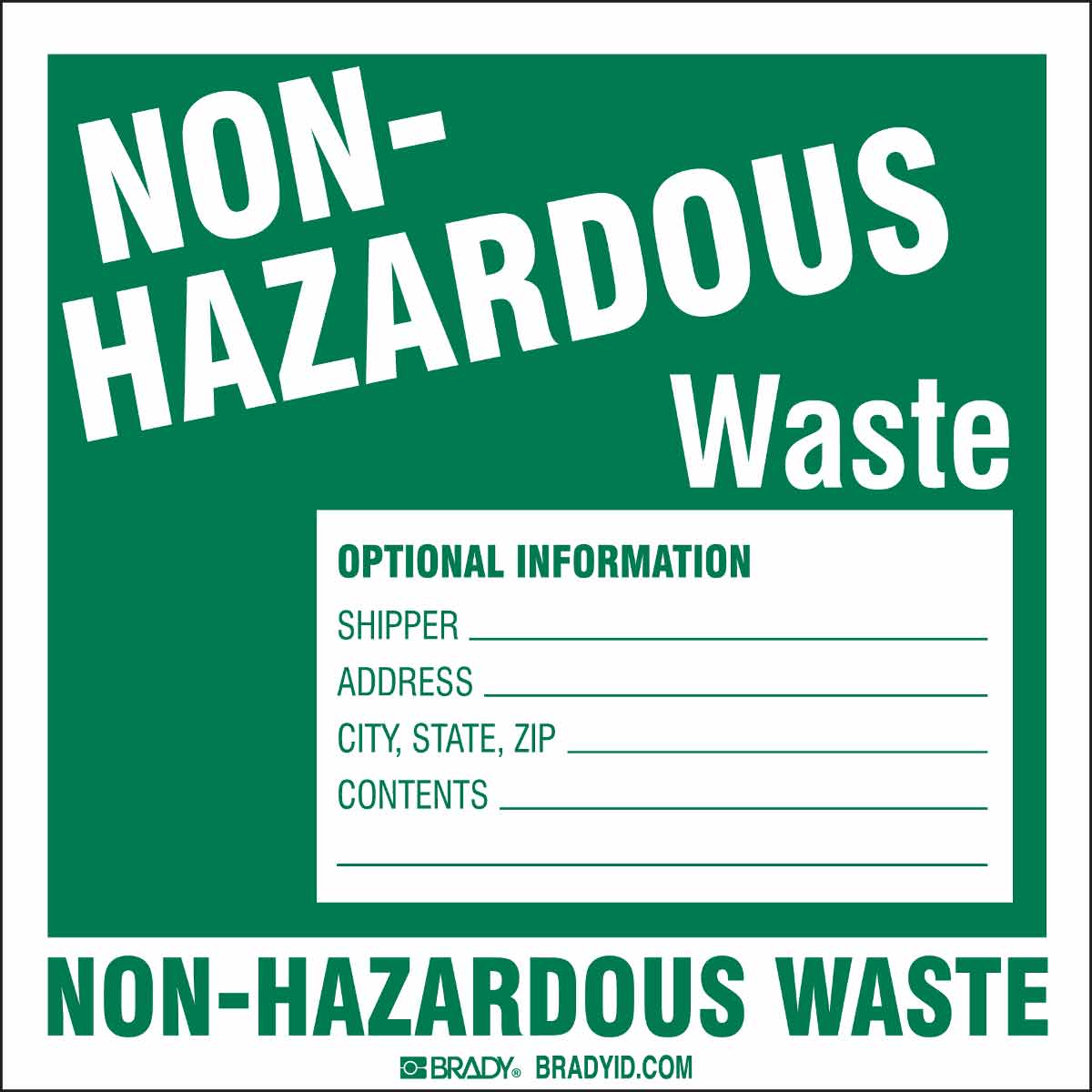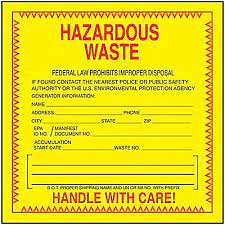Learn How and Why To Label Hazardous Waste Containers
Throughout my 25 years working in the hazardous waste industry I’ve learned that the most obvious and common sign that a company isn’t properly managing their hazardous waste obligations is failure to properly label waste containers.
In other words, if a company isn’t labeling properly, it almost always means that the company isn’t managing their other EPA/RCRA requirements either, including determining their generator status, completing waste determinations, training employees, developing waste procedures, P2 plans and more.
Unfortunately, this is exactly how EPA and state environmental inspectors see it as well. Where there’s smoke, there’s fire, and unlabeled waste containers are the smoking gun that can easily motivate the inspector to begin scrutinizing all of these other compliance issues, which can then lead to major fines and penalties for the company.
You might think I’m exaggerating, but that’s how it often works and one of our former clients actually received a $6000 fine for failing to label a single waste container!
Now that I hopefully have your attention, let’s continue. Here are the areas we’re going to discuss:
- Why it’s important to label your waste containers
- How to label waste containers
- EPA/RCRA labeling requirements
- DOT labeling requirements
- Common waste labels
- Other issues
Why It’s Important To Label Your Waste Containers
First off, EPA (Environmental Protection Agency), your state environmental agency (TCEQ in Texas for example) and DOT (US Department of Transportation) mandates that waste generators properly label their waste containers. We’ll get into their labeling requirements shortly, but the underlying reason for labeling is obviously to “make everyone” aware of the contents of all such waste containers.
This last point gets to the crux of the matter, waste generators must label their waste containers so that their employees, the regulators, the transporter and the treatment/disposal facility knows exactly what type of waste is involved.
Without a label, nothing can be done with the container(s). It can’t be shipped and it can’t be disposed of, all it can do is sit there until further action is taken.
I can’t tell you how many companies have contacted us over the years saying something to the effect of “we have a bunch of waste containers in our yard, but have no idea what’s in them. Can you give us a cost for disposing of everything?”
We call these waste projects and containers “unknowns.”
They always hate it when I tell them that nothing can be done until we figure out what’s inside each. If they’re lucky, someone on staff or who used to work for the company can help with the process, but more often than not they have to pay an environmental lab to start pulling samples and testing everything. The tests don’t actually determine what’s in the containers, but the results can help to determine how the waste must be classified and how it can be treated. Either way, it quickly becomes a very time consuming and expensive process for the company.
How to Label Waste Containers
We’ll get into the regulatory labeling requirements in a moment, but before getting there let’s quickly explain how your company should go about the process of labeling.
Step one goes back to the requirement to identify each of your company’s waste streams (including everything from plant trash, to recycled items to industrial and hazardous wastes) and then create waste determinations for each, where you’ll actually classify and characterize each according to RCRA/EPA regulations.
Once this process is done, you must then create a system for properly labeling each one of these waste streams, so that each time your company begins to fill a container, it can get properly labeled first. That’s right, you must label the container BEFORE you begin adding waste to it. This process will help prevent the possibility of containers getting lost in the shuffle and becoming “unknown.”
Before getting into regulatory labeling requirements, it’s important to understand that labeling, just like manifesting, involves EPA and DOT regulations.
On a related note, it’s also important to understand that there isn’t an official “hazardous waste labelling requirement” or standardize label. Instead, it’s a combination of both EPA and DOT guidance.
EPA/RCRA labeling requirements
To begin with, EPA stipulates that any waste container equal to or less than 119 gallons must be properly labeled. The standard waste container is a 55 gallon drum, but smaller containers can be used too.
Having said that, EPA requires the label to include the following information:
- “Hazardous Waste – Federal Law Prohibits Improper Disposal. If found, contact the nearest police or public safety authority or the US Environmental Protection Agency.”
- Generator’s name and address
- Generators EPA ID#
- For Small and Large Quantity Waste Generators, this is a 9 digit number which in Texas begins with TXR or TXD, followed by digits.
- If the generator is Conditionally Exempt in Texas, the ID# would be “TXCESQ”
- Manifest Tracking Number:
- When the generator is ready to ship the waste for disposal, they must add the manifest number, found in the top right corner, to the label. BTW, failure to do this is another very common violation because most companies aren’t aware of the requirement or fail to do it.
DOT labeling requirements
In addition to adding the manifest tracking number prior to shipping, DOT requires that waste generators label containers according to “Department of Transportation’s Hazardous Materials Regulations” which includes the following:
- 49 CFR Parts 173, 178, or 179 [40 CFR 262.30]; Package waste in accordance with these regulations
- 49 CFR Part 172, Subparts E and F respectively [40 CFR 262.31, 261.33]; and: Labeling and placarding in accordance with these CFRs
- 49 CFR Part 172, Subpart D [40 CFR 262.32(a): mark the container as a hazardous materials package per this CFR
- 49 CFR 172.301(a)]; Include the Proper Shipping Name and identification number of the hazardous material
- 49 CFR 173.301(d): Include name and address of the shipper and/or the designated recipient
- 49 CFR 173.400, 173.402]: Include diamond hazard labels for the primary (and most subsidiary) hazard classes of the hazardous material
Although DOT has very specific requirements within these CFRs, they don’t actually have specific label formats, other than stipulating that markings must be “durable, visible, in English, and not obscured or confused by other makings.
Common waste labels
As mentioned previously, neither EPA or DOT have specific labeling standards or formats, so instead there are “industry standard” labels that are widely available and used by most generators.
Below are the most common formats for Hazardous Waste and Non-Hazardous waste. You’ll notice that each contains at least the minimum information required by both agencies.
Other Labeling Issues To Consider
We’ll begin to wrap up by addressing 3 other labeling issues that you’ll want to be aware of:
- Only include one label on your waste containers: It’s very common for waste generators to use empty drums from chemicals previously purchased and used. These drums always contain the original chemical labels, which must either be removed or painted over. In other words, the waste container cannot have the waste label and the original chemical label, because this can create uncertainty as to what’s actually in the container.
- Don’t use “home made” labels: Although it’s possible to create labels yourself that meet EPA and DOT requirements, it’s not a good practice because they often don’t contain all required information, and normally don’t meet the “durable” requirement stated by DOT. I’ve seen many laminated or printed labels, which are better than nothing, but I’ve never seen any that meet all requirements.
- Make sure that information is legible: It’s very common to see labels that contain all required information, but the hand-writing isn’t legible. This is often caused by staff writing the information only after the label has been affixed to the container. It’s always best to write all information on the label before affixing to the container.
There you have it, all of the basic information needed to properly label your hazardous waste containers.
Making the effort to implement a compliant hazardous waste labeling system might seem like a daunting task, but it’s the law and can end up being much easier and less expensive than dealing with “unknowns” or regulatory fines and penalties!
It can be and seem overwhelming, so feel free to contact us with questions or concerns.



